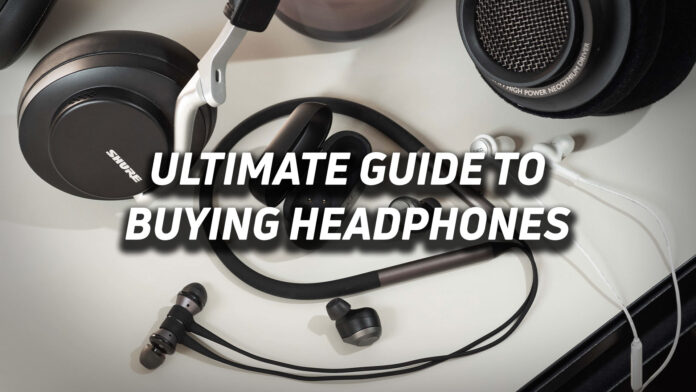The Best Earbuds (In-Ear Headphones) for 2021
If you’re a music lover, chances are you’re not happy with your phone or media player’s bundled in-ear headphones. Most of the time, they sound pretty dismal. Some devices don’t come with any earphones at all, but even the models that do include them tend not to offer a high-quality listening experience. Your music and video can definitely benefit from an upgrade.
Earphones vs. Earbuds
Technically speaking, earbuds are not earphones, as they don’t enter your ear canal. Instead they sit just outside of it, where it’s easy to become loose and cause problems when it comes to accurate stereo imaging (in which both ears get the same amount of audio) and bass response. Earphones, meanwhile, fit in the ear canal and form a seal inside your ear, blocking outside noise while piping sound directly into your ears. They’re much smaller and lighter than headphones, since they don’t need to fit on or over your ears and don’t require any outside support (though some have stiff wire sections or flexible fins to keep them in place without getting in the way). Plus they won’t mess up your hair.
That said, the term earbuds has become synonymous with earphones and in-ear headphones, so the difference is ultimately academic. Whatever you call them and whatever they say on the box, you should look for earphones that form a good seal inside your ear with silicone or foam eartips. They’ll sound much better than plastic-covered drivers cupped against your ear canal.
Wired, Wireless, or Wire-Free?
Earphones can connect to your smartphone through a 3.5mm cable or wirelessly over Bluetooth, depending on the model. Wired earphones are generally less expensive, and you don’t need to worry about keeping them charged. Bluetooth earphones are more convenient because you don’t have to physically connect them to your smartphone, but they need battery power to work. For the most part, you won’t find a 3.5mm port and removable cable on Bluetooth earphones; when they’re out of power, they’re out of commission until you charge them again.
There’s also true wireless earbuds, which we also call wire-free. These are essentially Bluetooth earphones, but with no cable connecting the individual earpieces. It took a solid year for the bugs to get shaken out of this category, with issues like short battery life and awkward design plaguing early devices.
We’re starting to see some very compelling wire-free earphones now, with companies like Bose and JLab offering sets with the power, longevity, and intuitive controls necessary for us to recommend them. Typically wire-free earphones were more expensive than conventional wireless earphones, but there are now several compelling sets available for under $150 or even under $100.
Good for Workouts
Earphones might not be as eye-catching as in-ear headphones, but they can be much more convenient. Besides their size and weight, earphones are often more resilient than headphones when dealing with moisture. This is important if you want to listen to music at the gym. Earpads can get soaked and worn with a solid sweat, and they aren’t built to withstand the regular, constant friction that comes with working out. Earphones can be built to be water- and sweat-resistant, and hold up much better to activity.
Besides the rugged factor, earphones are also much better for staying on your head while you’re in motion. A good set of headphones will feel comfortable when you’re sitting or walking around, but when you start running or biking they can easily shake free of your ears. Fitness-oriented earphones often have stabilizing fins built in to them to ensure that they’ll stay in place no matter what you do at the gym. For the best options, check out our lists of The Best Headphones for Running and The Best True Wireless Earbuds for Running.
Not all earphones are workout-friendly, though; don’t assume your earphones will handle what you throw at them unless they’re fitness-oriented earphones, or at least are explicitly listed as water- and sweat-resistant. Really pricey earphones can be as fragile as really pricey headphones, and you don’t want to accidentally ruin a $200 pair with ear sweat.
Caring for Your Earphones
Whichever model you choose, make sure to use the included pouch or carrying case as often as possible in order to preserve the longevity of your earphones. Balling them up, shoving them into a pocket, and then untangling them each time you want to listen does more to wear them out prematurely than just about anything else. For more details, check out Five Easy Tips to Extend the Life of Your in-ear headphones.
And if you’re shopping on a budget, scan our picks for the Best Headphones Under $50 and the Best Cheap True Wireless Earbuds.
The Best Earbuds (In-Ear Headphones) for 2021
| Our Pick | Rating | Wireless | Wire-Free | Water/Sweat-Resistant | Type | True Wireless | Removable Cable | Phone Controls | Connection Type | Boom Mic |
|---|---|---|---|---|---|---|---|---|---|---|
| Etymotic ER3 XR | Excellent (4.5) | No | No | No | In-Canal | Yes | No | Stereo 3.5mm | No | |
| Apple AirPods Pro | Excellent (4.0) | Yes | Yes | In-Canal | Yes | Bluetooth, Apple H1 | ||||
| Anker Soundcore Liberty Air 2 Pro | Excellent (4.0) | Yes | Yes | In-Ear | Yes | Bluetooth | ||||
| Back Bay Audio American EQ 40 | Excellent (4.0) | Yes | No | Yes | In-Canal | Yes | Yes | Bluetooth, USB-C, Stereo 3.5mm | No | |
| Jabra Elite Active 75t Earbuds | Excellent (4.0) | Yes | Yes | In-Canal | Yes | Bluetooth | ||||
| Bose QuietComfort Earbuds | Excellent (4.0) | Yes | Yes | In-Canal | Yes | Bluetooth | ||||
| JayBird X4 | Excellent (4.0) | Yes | No | Yes | In-Canal | No | Yes | Bluetooth | No | |
| RHA T20 Wireless | Excellent (4.0) | Yes | No | In-Canal | No | Bluetooth | ||||
| JBL UA True Wireless Flash | Excellent (4.0) | Yes | Yes | Yes | In-Canal | No | Yes | Bluetooth | No | |
| Amazon Echo Buds | Excellent (4.0) | Yes | Yes | In-Canal | Yes | Bluetooth |
What if you don’t have an in-ear headphones jack anymore?
Unfortunately, more and more phones are ditching the standard headphone jack in favor of USB-C. Besides not being able to charge and play music at the same time, this also means that your options are fairly limited if you want a good pair of wired earbuds to use every day. Of course, you could always use any of the earbuds on this list with a dongle, but if dongles aren’t your style then don’t worry. We have a list of the best USB-C earbuds you can get so make sure to check that out if none of these piqued your interest.
What you should know about the best in-ear headphones
Chances are you’ve been using earbuds for years, but there are still things that you should be aware of when making a purchase decision. First and foremost: safety.
Though we usually say you should try and get your hands on a pair of in-ear headphones to try for yourself before buying, it’s a little harder with in-ears. You don’t want to be going to local electronics and just sticking things in your ears. Who knows who’s tried them out before you. It’s kind of gross if you think about it too much, but there are also infections that can be passed along that way. So, while it’s usually okay to go trying out over-ear headphones, you should take some precautions when it comes to in-ears like alcohol swabs or even your own pair of ear tips.
Look at Bluetooth codec compatibility
Although there are plenty of wired picks listed, some companies have cut the cord. If you’re looking to do the same, get the most out of your Bluetooth streaming by investing in earbuds with high-quality codec support.
If you don’t have time for a detailed breakdown of how codecs work, here’s the abridged version: they determine how data is transmitted from your smartphone to your wireless in-ear headphones. Different codecs make different compromises in quality and efficiency. SBC is the lowest common denominator of the Bluetooth codecs. Its support is required by all Bluetooth audio products.
Android users shouldn’t settle for AAC support as its performance is dubious at best unless used with an iPhone. Additionally, LDAC isn’t as high-res as we’re lead to believe. Ultimately, though, if you’re short on cash and can’t afford wireless earbuds with aptX or AAC support, you can rest easy knowing that most of our ears are too old or damaged to perceive a difference.
Isolation plays an important role
Which brings us to the next thing that you should know when buying a pair of buds: fit. Regardless of whether you’re using in-ears or over-ears, isolation is extremely important. In the case of earbuds, you don’t have the luxury of large cups and leather to block out sound. If the earbud tip isn’t a good fit, you’re not only going to have a hard time keeping them from falling out of your ear, but you’re going to be letting in all kinds of outside noise.
However, if you’re looking for earbuds specifically for working out, it might beseech you to look for earbuds that have an ambient aware mode or ones that don’t isolate super well. This will allow you to remain aware of your surroundings while exercising, whether that’s in the gym surrounded by other people and heavy machinery, or on a run outside in the midst of traffic.
Luckily, earbuds usually come with a few different options so you can mix and match until you get the perfect fit, but one thing I’ve learned in my experience is just to invest in a good set of comply memory foam tips for yourself. Not only are they super comfortable and keep the buds in your ears, they also do a solid job of blocking outside noise. This is of course not possible with true in-ears like the Etymotic ER4SR, but those also don’t have this problem because of how far into your ears they sit.
One thing about wired earbuds that gets overlooked is just how damn good sound quality is. Sure, Bluetooth is more convenient and has plenty of benefits but dollar-for-dollar, some of the best earbuds blow away their wireless competition. Bluetooth sound quality is OK, and there are plenty of options out there—but wired in-ear headphones aren’t limited by data transfer speeds in the same way that Bluetooth ones are. Plus if you happen to keep your source files on the device, it’s actually not limited by data transfer speeds at all.
Noise-induced hearing loss
Unfortunately, we as humans don’t hear perfectly. The typical human range of hearing is 20Hz-20kHz. Depending on your age or how often you’ve been subjected to loud noises (like going to concerts), you might not be able to hear everything in that range. There really isn’t any way to avoid this as we’re surrounded by loud noises and are aging by the minute, but you can prevent the worst of it.
Some types of hearing loss are irreversible, but you can equip yourself with knowledge of how it occurs by reading our explainer piece. You can still take care of your remaining hearing by limiting volume levels to 85dB. That’s the recommended limit for safe-listening, and because earbuds are much closer to your ears than the speakers at a concert it’s even more important to keep that limit in mind.
How we chose the Best in-ear headphones
Disclaimer: Regardless of what we put on this list, we definitely missed some great options. That isn’t because we decided to ignore them, but because there are hundreds of great buds out there. Picking five came down to a few main things. First was affordability. You can go deep down the rabbit hole when it comes to in-ear headphones.
Spending hundreds of dollars on a pair of buds isn’t an easy decision and we don’t take it lightly, but when the alternative is spending thousands on insanely high-end IEMs we consider these relatively affordable. At the same time, you’ll eventually get to a point of diminishing return. It’s true you’ll find some amazing headphones if you spend upwards of $1,000, but are they really $800 better than our top pick? We don’t think so.
After price, the most important feature quickly becomes sound quality. Luckily, there are plenty of options here. Unlike Bluetooth headphones, in-ears are all about the hardware rather than software. And companies have had decades to fine-tune the sound for the best experience, resulting in plenty of great sounding buds that won’t cost you too much.
Comfort is important too, but there are a lot of variabilities there. Not all of our observations are going to hold true for everyone. Consequently, we didn’t spend a ton of time waxing poetic about this feature, because your experiences will differ from ours; you have different ears, after all! Additionally, there remain some third party foam tip options for you to consider—offering even better isolation and fit than the standard silicone tips. Good ear tips will make even the best earbuds sound even better.



